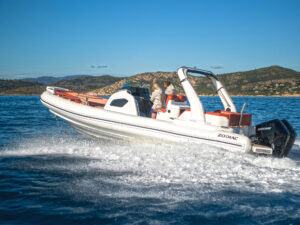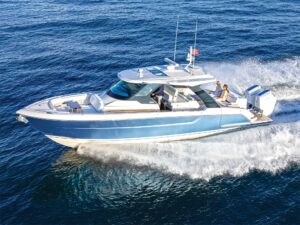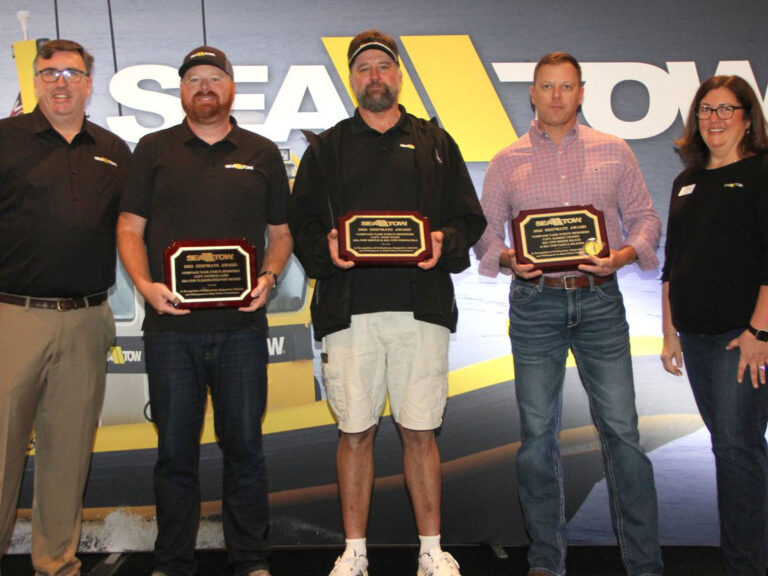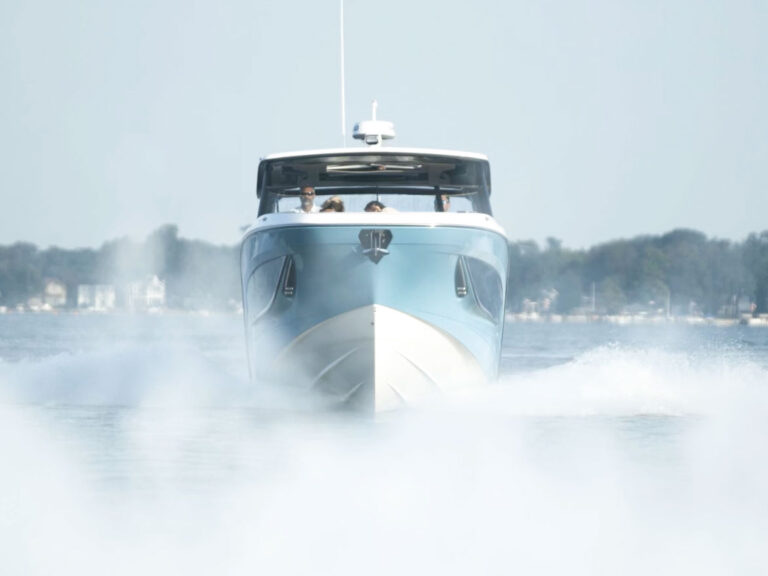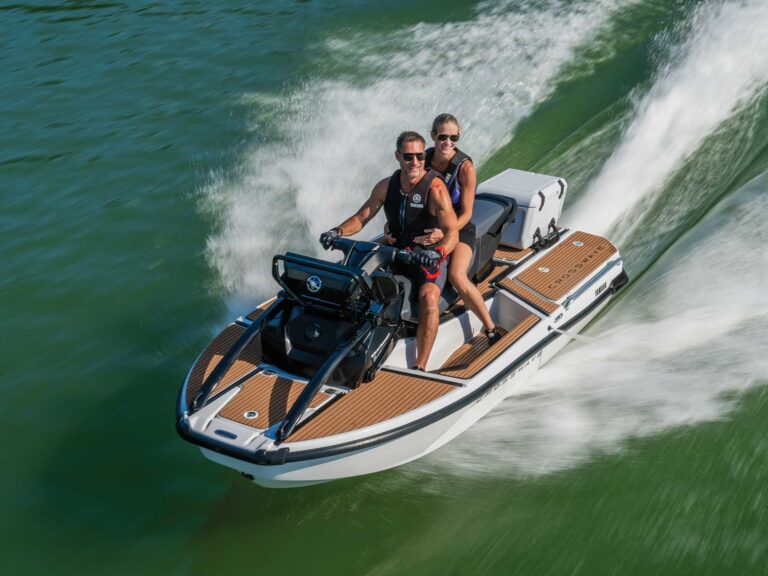
The first question we asked about Mercury’s V-10 Verado outboards is why a V-10? The answer proved straightforward. By maintaining the 64-degree cylinder angle of the V-8 Verado 250/300 hp motors, Mercury can offer a 350/400 hp V-10 that maintains standard 26-inch multi-engine transom spacing. This eases rigging new boats and repowers. A V-8 with the same 5.7-liter displacement would need to be wider; for example, the 60-degree, 5.6-liter V-8 Yamaha XTO 425 requires 28.5-inch spacing.
Merc’s V-10 models herald the retirement of the 19-year-old supercharged 2.6-liter Verado inline-six platform. Mercury now believes that displacement, not supercharging, proves superior for making effective outboard power. The performance we experienced aboard a variety of boats during a press preview verified that axiom. The torque curve feels fat and flat; these motors pull hard through the entire rpm range. This athletic feeling stands in contrast to that of the 2.6-liter 400 hp models, which require 400 more rpm to make peak power as torque tails off in the upper rpm range.
With a 25-inch shaft, the V-10 Verado weighs 709 pounds dry. That’s 27 pounds more than the 2.6-liter Verado, but 18 pounds less than a Suzuki DF350, and 243 pounds lighter than Yamaha’s 425 XTO.
The V-10 powerhead shares its basic architecture with V-8 Verado models, including bore, stroke, quad-cam and four-valve cylinder heads, and computer-controlled spark advance and fuel calibration to enhance power and range. The Mercury Advanced Midsection isolates the powerhead from the boat. Digital controls, auto trim and power steering are standard. Adaptive Speed Control maintains engine rpm as load changes, when climbing swells, for example. The motors are compatible with all of the Mercury SmartCraft technologies, VesselView displays and the VesselView Mobile app. The dipstick and oil fill are located under the clever Top Cowl service door. The motor makes full power on 87-octane fuel. We’ve seen all of these features on the V-8 Verados, but here’s what’s exclusive to the V-10s.

Gear Case and Props
An all-new 6.4-inch-diameter gear case and Revolution X propellers were designed specifically for powering large, heavy boats. An inch larger than the gear case on previous Verado models, the new design accommodates a 2.08-to-1 gear ratio, 19 percent lower than the 1.75-to-1 ratio of the 300 hp V-8 Verado. Bigger gears are stronger, of course, as is a stout 1.5-inch-diameter prop shaft. Revolution X props will range from 18- to 33-inch pitch, each with a specific diameter up to about 17 inches. Tim Reid, Mercury vice president of product development and engineering, says extensive use of computational fluid dynamics refined the shape of the gear case to maximize lift and reduce drag. While the larger case will create more drag, Mercury says the lift it generates “dries out the hull” and offsets the gear-case drag. Builders are also rigging the V-10 one mounting hole higher (0.75 inch) than the 2.6-liter motors, and fast boats can run this gear case at a semi-surfacing height. Mercury says the V-10 has been tested at more than 90 mph.
The 2.08-to-1 ratio amplifies torque to four-blade Revolution X props that offer 35 to 50 percent more blade area than props for the 2.6-liter Verado 400 model, according to Merc. Blade area provides the thrust to push heavy boats on plane with authority and hold them there at lower speeds, with outstanding steering response at low speeds. Propeller speed is reduced, which improves prop efficiency. The expanded pitch range of the Revolution X line ensures that fast boats can find plenty of speed. The props use a new rubber-cushioned Flo-Torq X modular hub that fits a slight taper in the prop shaft, improving prop stability.
Revolution X props also sport eight vent holes in the hub, one on the suction side, and—this is the new feature—another on the pressure side of each blade. In reverse, exhaust vents through the new holes so that the prop is working in clean water while the exhaust passes below the boat. Mercury says this greatly improves thrust and steering in reverse, especially on boats equipped with JPO (Joystick Piloting for Outboards).
Charging
A new alternator delivers 150 amps of charging power at just 1,500 rpm, more than twice that of 2.6-liter Verados and 30 percent more than the Verado V-8s. For comparison, Yamaha’s XTO 425 puts out 100 amps, while the Suzuki DF350 creates 54 amps. Mercury and a partner have also developed a new 48-volt alternator to charge the latest Navico Fathom e-Power lithium-battery-based auxiliary power system that serves as a replacement for an onboard generator.
Read Next: Mercury Introduces V12 600hp Outboard

Electric Power Steering
The electric power-steering system mounts on the motor bracket. Electric steering will become available as an option for Verado V-8 and V-10 models beginning in February. By midsummer, electric steering will be standard on all JPO-equipped boats and optional on all non-joystick V-8 or V-10 Verado-powered boats. The enhanced response and precision of electric steering is most notable in low-speed JPO maneuvers and much easier to rig than an electrohydraulic system. Motors with electric steering will not reach dealers for retail sale until late 2023, so the pricing is not yet available.
With the introduction of the Verado V-10, Mercury has completed the transformation of its large outboard offering. We look forward to getting more experience with this motor in future boat tests.
Specs
| Displacement: | 5.8 liters |
| Shaft Lengths (in.): | 25, 30, 35 |
| Dry Weight (25 in.): | 709 lb. |
| Alternator: | 12V 150A at 1,500 rpm; 48V 4.6 kW (optional) |
| Price: | About $40,000 |



